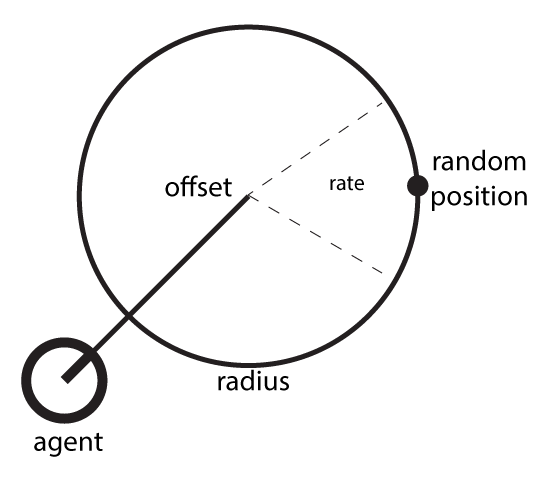This technique works like a charm for random crowd simulations, animals, and almost any kind of NPC that requires random movement when idle.
Wandering around
Getting ready
We need to add another function to our AgentBehaviour class called OriToVec, which converts an orientation value to a vector:
public Vector3 GetOriAsVec (float orientation) {
Vector3 vector = Vector3.zero;
vector.x = Mathf.Sin(orientation * Mathf.Deg2Rad) * 1.0f;
vector.z = Mathf.Cos(orientation * Mathf.Deg2Rad) * 1.0f;
return vector.normalized;
}
How to do it...
We can regard it as a big three-step process in which we first manipulate the internal target position in a parameterized random way, face that position, and move accordingly:
- Create the Wander class deriving from Face:
using UnityEngine;
using System.Collections;
public class Wander : Face
{
public float offset;
public float radius;
public float rate;
}
- Define the Awake function in order to set up the internal target:
public override void Awake()
{
target = new GameObject();
target.transform.position = transform.position;
base.Awake();
}
- Define the GetSteering function:
public override Steering GetSteering()
{
Steering steering = new Steering();
float wanderOrientation = Random.Range(-1.0f, 1.0f) * rate;
float targetOrientation = wanderOrientation + agent.orientation;
Vector3 orientationVec = OriToVec(agent.orientation);
Vector3 targetPosition = (offset * orientationVec) + transform.position;
targetPosition = targetPosition + (OriToVec(targetOrientation) * radius);
targetAux.transform.position = targetPosition;
steering = base.GetSteering();
steering.linear = targetAux.transform.position - transform.position;
steering.linear.Normalize();
steering.linear *= agent.maxAccel;
return steering;
}
How it works...
The behavior takes two radii in order into consideration to get a random position to go next, looks toward that random point, and converts the computed orientation into a direction vector in order to advance:

A visual description of the parameters for creating the Wander behavior






























































